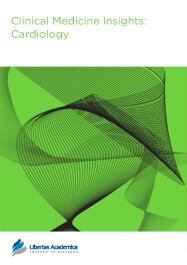

Publication Date: 15 Dec 2010
Type: Original Research
Journal: Clinical Medicine Insights: Cardiology
Citation: Clinical Medicine Insights: Cardiology 2010:4 129-134
doi: 10.4137/CMC.S5900

Introduction: Dilated cardiomyopathy (DCM) is associated with significant morbidity and mortality. Contrast-enhanced cardiac MRI (CE-CMR) can detect potentially prognostic myocardial fibrosis in DCM. We investigated the role of CE-CMR in New Zealand patients with DCM, both Maori and non-Maori, including the characteristics and prognostic importance of fibrosis.
Methods: One hundred and three patients (mean age 58 ± 13, 78 male) referred for CMR assessment of DCM were followed for 660 ± 346 days. Major adverse cardiac events (MACE) were defined as death, infarction, ventricular arrhythmias or rehospitalisation. CE-CMR used cines for functional analysis, and delayed enhancement to assess fibrosis.
Results: Myocardial fibrosis wa s present in 30% of patients, the majority of which was mid-myocardial (63%). Volumetric parameters were similar in patients with or without fibrosis. At 2 years patients with fibrosis had an increased rate of MACE (HR = 0.77, 95% CI 0.32.0). Patients with full thickness or subendocardial fibrosis had the highest MACE, even in the absence of CAD). More Maori had fibrosis on CE-CMR (40% vs. 28% for non-Maori), and the majority (75%) was mid-myocardial. Maori and non-Maori had similar outcomes (25% vs. 24% with events during follow-up).
Conclusions: DCM patients frequently have myocardial fibrosis detected on CE-CMR, the majority of which is mid-myocardial. Fibrosis is associated with worse outcome in the medium term. The information obtained using CE-CMR in DCM may be of incremental clinical benefit.
PDF (794.09 KB PDF FORMAT)
RIS citation (ENDNOTE, REFERENCE MANAGER, PROCITE, REFWORKS)
BibTex citation (BIBDESK, LATEX)
XML
PMC HTML

My co-authors and I had a very positive experience with the review and publication process in Clinical Medicine Insights: Cardiology. The review was on point, and publication was also rapid and allowed us the needed revisions in the proof preparation process.

All authors are surveyed after their articles are published. Authors are asked to rate their experience in a variety of areas, and their responses help us to monitor our performance. Presented here are their responses in some key areas. No 'poor' or 'very poor' responses were received; these are represented in the 'other' category.See Our Results
Copyright © 2014 Libertas Academica Ltd (except open access articles and accompanying metadata and supplementary files.)
Facebook Google+ Twitter
Pinterest Tumblr YouTube